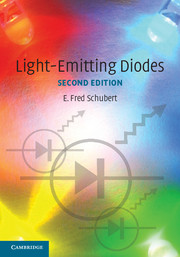Book contents
- Frontmatter
- Contents
- Preface
- 1 History of light-emitting diodes
- 2 Radiative and non-radiative recombination
- 3 Theory of radiative recombination
- 4 LED basics: Electrical properties
- 5 LED basics: Optical properties
- 6 Junction and carrier temperatures
- 7 High internal efficiency designs
- 8 Design of current flow
- 9 High extraction efficiency structures
- 10 Reflectors
- 11 Packaging
- 12 Visible-spectrum LEDs
- 13 The AlGaInN material system and ultraviolet emitters
- 14 Spontaneous emission from resonant cavities
- 15 Resonant-cavity light-emitting diodes
- 16 Human eye sensitivity and photometric qualities
- 17 Colorimetry
- 18 Planckian sources and color temperature
- 19 Color mixing and color rendering
- 20 White-light sources based on LEDs
- 21 White-light sources based on wavelength converters
- 22 Optical communication
- 23 Communication LEDs
- 24 LED modulation characteristics
- Appendix 1 Frequently used symbols
- Appendix 2 Physical constants
- Appendix 3 Room temperature properties of III–V arsenides
- Appendix 4 Room temperature properties of III–V nitrides
- Appendix 5 Room temperature properties of III–V phosphides
- Appendix 6 Room temperature properties of Si and Ge
- Appendix 7 Periodic system of elements (basic version)
- Appendix 8 Periodic system of elements (detailed version)
- Index
8 - Design of current flow
Published online by Cambridge University Press: 05 September 2012
- Frontmatter
- Contents
- Preface
- 1 History of light-emitting diodes
- 2 Radiative and non-radiative recombination
- 3 Theory of radiative recombination
- 4 LED basics: Electrical properties
- 5 LED basics: Optical properties
- 6 Junction and carrier temperatures
- 7 High internal efficiency designs
- 8 Design of current flow
- 9 High extraction efficiency structures
- 10 Reflectors
- 11 Packaging
- 12 Visible-spectrum LEDs
- 13 The AlGaInN material system and ultraviolet emitters
- 14 Spontaneous emission from resonant cavities
- 15 Resonant-cavity light-emitting diodes
- 16 Human eye sensitivity and photometric qualities
- 17 Colorimetry
- 18 Planckian sources and color temperature
- 19 Color mixing and color rendering
- 20 White-light sources based on LEDs
- 21 White-light sources based on wavelength converters
- 22 Optical communication
- 23 Communication LEDs
- 24 LED modulation characteristics
- Appendix 1 Frequently used symbols
- Appendix 2 Physical constants
- Appendix 3 Room temperature properties of III–V arsenides
- Appendix 4 Room temperature properties of III–V nitrides
- Appendix 5 Room temperature properties of III–V phosphides
- Appendix 6 Room temperature properties of Si and Ge
- Appendix 7 Periodic system of elements (basic version)
- Appendix 8 Periodic system of elements (detailed version)
- Index
Summary
LEDs may be grown on conductive and insulating substrates. Whereas the current flow is mostly vertical (normal to the substrate plane) in structures grown on conductive substrates, it is mostly lateral (horizontal) in devices grown on insulating substrates. The location and size of ohmic contacts are relevant to light extraction, because metal contacts are opaque. The current chapter discusses the current flow patterns of different device structures aimed at high extraction efficiency.
Current-spreading layer
In LEDs with thin top confinement layers, the current is injected into the active region mostly under the top electrode. Thus, light is generated under an opaque metal electrode. This results in a low extraction efficiency. This problem can be avoided with a current-spreading layer that spreads the current under the top electrode to regions not covered by the opaque top electrode.
The current-spreading layer is synonymous with the window layer. The term window layer is occasionally used to emphasize the transparent character of this layer and its ability to enhance the extraction efficiency.
The usefulness of current-spreading layers was realized during the infancy of LEDs. Nuese et al. (1969) demonstrated a substantial improvement of the optical output power in GaAsP LEDs by employing a current-spreading or window layer. The window layer is the top semiconductor layer located between the upper cladding layer and the top ohmic contact. The effect of a current-spreading layer is illustrated in Fig. 8.1.
- Type
- Chapter
- Information
- Light-Emitting Diodes , pp. 127 - 144Publisher: Cambridge University PressPrint publication year: 2006
- 1
- Cited by

